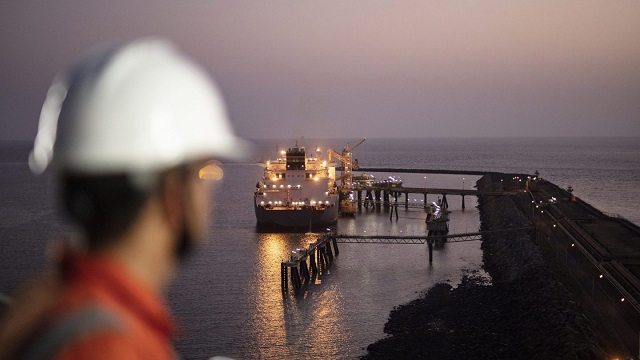Canadian Energy Centre
New deal with global gas giant Shell shows Canada is on the map for LNG: specialist

A worker at Shell’s Hazira LNG import terminal, about 250 kilometers from Mumbai, India. Photo courtesy Shell
From the Canadian Energy Centre
By Deborah Jaremko‘This is a signal that the LNG demand is viable beyond 2050’
A new 20-year deal by global energy giant Shell to purchase liquefied natural gas (LNG) from British Columbia is a sign Canada is becoming a player in global LNG markets, says an industry specialist.
Shell has agreed to buy two million tonnes of LNG per year from the proposed Ksi Lisims LNG project located near the Alaska border, which could start operating in 2028.
“Canada is on the map now for LNG. This is a signal that the LNG demand is viable beyond 2050,” says Racim Gribaa, president of Calgary-based Global LNG Consulting.
Gribaa has worked in energy for more than two decades, engaging with governments and industry on LNG developments around the world including Malaysia, the United States, Canada and Qatar.
Long-term LNG deals like the one struck by Ksi Lisims and Shell are hard to come by, he says, and are a sign that so-called LNG “portfolio players” trust the ability of Canada’s natural gas industry to deliver.
A portfolio player like Shell buys LNG from various suppliers and distributes it to buyers around the world – versus a buyer that purchases LNG solely for its own use.
“When portfolio players buy LNG, it’s not necessarily for a specific country. They can sell it anywhere they want,” Gribaa says.
“Canada’s west coast can enable them to sell cargo to efficiently meet demand in Asia without having to ship it all the way from farther locations. Instead of them shipping cargo from the Middle East, Europe, or from the U.S. thereby avoiding longer journeys around the Cape or going through the Strait of Hormuz or Panama Canal, instead they just send it straight from Canada to where they need it to go. It’s economically and logistically beneficial for them.”
Driven by expanding economies in Asia, world LNG trade has increased by more than 200 per cent since 2000, reaching 401 million tonnes in 2022, according to the International Gas Union.
Global natural gas use is rising, driving increased demand for LNG. The U.S. Energy Information Administration’s latest outlook projects natural gas consumption will rise to 197 quadrillion BTU in 2050, up from 153 quadrillion BTU in 2022.
In addition to the deal with Ksi Lisims owners including the Nisga’a Nation, Shell is also lead owner of the LNG Canada project, which is nearing completion at Kitimat, B.C.
The terminal will have capacity of 14 million tonnes per year when it starts up in 2025. The buyers of the exports from LNG Canada are its owners, including Shell and Petronas.
Shell’s decision to purchase LNG from Ksi Lisims could ensure it has plentiful supply available regardless of the timeline of the second phase of LNG Canada, Gribaa says.
“For a portfolio player, having options is valuable. We have enough demand globally to meet both Ksi Lisims LNG and LNG Canada phase 2, especially as coal is gradually faded out from Asia’s power mix,” he says.
“The only viable solution is to replace it with natural gas through LNG, as well as renewables, so the demand is forecast to be strong for several decades to come.”
Growing Canada’s LNG exports to Asia could reduce emissions by 188 million tonnes per year, or the annual equivalent of taking all internal combustion engine vehicles off Canadian roads, according to a 2022 study by Wood Mackenzie.
Down the coast from LNG Canada at Squamish, B.C. another major portfolio player is leaning on Canadian LNG.
BP Gas Marketing is the foundational customer for the Woodfibre LNG project, where early construction is underway.
Over a 15-year period, BP will purchase 1.95 million tonnes of the project’s 2.1 million tonne per year LNG capacity, and the remaining 0.15 million tonnes per year “on a flexible basis.”
“When you have such commercial commitments inked, it provides a future perspective on supply and demand, and perhaps most importantly it asserts the importance of Canada’s role in providing the world with a clean, affordable and secure long term LNG supply,” Gribaa says.
Canadian Energy Centre
Saskatchewan Indigenous leaders urging need for access to natural gas

Piapot First Nation near Regina, Saskatchewan. Photo courtesy Piapot First Nation/Facebook
From the Canadian Energy Centre
By Cody Ciona and Deborah Jaremko
“Come to my nation and see how my people are living, and the struggles that they have day to day out here because of the high cost of energy, of electric heat and propane.”
Indigenous communities across Canada need access to natural gas to reduce energy poverty, says a new report by Energy for a Secure Future (ESF).
It’s a serious issue that needs to be addressed, say Indigenous community and business leaders in Saskatchewan.
“We’re here today to implore upon the federal government that we need the installation of natural gas and access to natural gas so that we can have safe and reliable service,” said Guy Lonechild, CEO of the Regina-based First Nations Power Authority, on a March 11 ESF webinar.
Last year, 20 Saskatchewan communities moved a resolution at the Assembly of First Nations’ annual general assembly calling on the federal government to “immediately enhance” First Nations financial supports for “more desirable energy security measures such as natural gas for home heating.”
“We’ve been calling it heat poverty because that’s what it really is…our families are finding that they have to either choose between buying groceries or heating their home,” Chief Christine Longjohn of Sturgeon Lake First Nation said in the ESF report.
“We should be able to live comfortably within our homes. We want to be just like every other homeowner that has that choice to be able to use natural gas.”
At least 333 First Nations communities across Canada are not connected to natural gas utilities, according to the Canada Energy Regulator (CER).
ESF says that while there are many federal programs that help cover the upfront costs of accessing electricity, primarily from renewable sources, there are no comparable ones to support natural gas access.
“Most Canadian and Indigenous communities support actions to address climate change. However, the policy priority of reducing fossil fuel use has had unintended consequences,” the ESF report said.
“Recent funding support has been directed not at improving reliability or affordability of the energy, but rather at sustainability.”
Natural gas costs less than half — or even a quarter — of electricity prices in Alberta, British Columbia, Ontario, Manitoba and Saskatchewan, according to CER data.
“Natural gas is something NRCan [Natural Resources Canada] will not fund. It’s not considered a renewable for them,” said Chief Mark Fox of the Piapot First Nation, located about 50 kilometres northeast of Regina.
“Come to my nation and see how my people are living, and the struggles that they have day to day out here because of the high cost of energy, of electric heat and propane.”
According to ESF, some Indigenous communities compare the challenge of natural gas access to the multiyear effort to raise awareness and, ultimately funding, to address poor water quality and access on reserve.
“Natural gas is the new water,” Lonechild said.
Alberta
The beauty of economic corridors: Inside Alberta’s work to link products with new markets

From the Canadian Energy Centre
Q&A with Devin Dreeshen, Minister of Transport and Economic Corridors
CEC: How have recent developments impacted Alberta’s ability to expand trade routes and access new markets for energy and natural resources?
Dreeshen: With the U.S. trade dispute going on right now, it’s great to see that other provinces and the federal government are taking an interest in our east, west and northern trade routes, something that we in Alberta have been advocating for a long time.
We signed agreements with Saskatchewan and Manitoba to have an economic corridor to stretch across the prairies, as well as a recent agreement with the Northwest Territories to go north. With the leadership of Premier Danielle Smith, she’s been working on a BC, prairie and three northern territories economic corridor agreement with pretty much the entire western and northern block of Canada.
There has been a tremendous amount of work trying to get Alberta products to market and to make sure we can build big projects in Canada again.
CEC: Which infrastructure projects, whether pipeline, rail or port expansions, do you see as the most viable for improving Alberta’s global market access?
Dreeshen: We look at everything. Obviously, pipelines are the safest way to transport oil and gas, but also rail is part of the mix of getting over four million barrels per day to markets around the world.
The beauty of economic corridors is that it’s a swath of land that can have any type of utility in it, whether it be a roadway, railway, pipeline or a utility line. When you have all the environmental permits that are approved in a timely manner, and you have that designated swath of land, it politically de-risks any type of project.
CEC: A key focus of your ministry has been expanding trade corridors, including an agreement with Saskatchewan and Manitoba to explore access to Hudson’s Bay. Is there any interest from industry in developing this corridor further?
Dreeshen: There’s been lots of talk [about] Hudson Bay, a trade corridor with rail and port access. We’ve seen some improvements to go to Churchill, but also an interest in the Nelson River.
We’re starting to see more confidence in the private sector and industry wanting to build these projects. It’s great that governments can get together and work on a common goal to build things here in Canada.
CEC: What is your vision for Alberta’s future as a leader in global trade, and how do economic corridors fit into that strategy?
Dreeshen: Premier Smith has talked about C-69 being repealed by the federal government [and] the reversal of the West Coast tanker ban, which targets Alberta energy going west out of the Pacific.
There’s a lot of work that needs to be done on the federal side. Alberta has been doing a lot of the heavy lifting when it comes to economic corridors.
We’ve asked the federal government if they could develop an economic corridor agency. We want to make sure that the federal government can come to the table, work with provinces [and] work with First Nations across this country to make sure that we can see these projects being built again here in Canada.
-

 Catherine Herridge2 days ago
Catherine Herridge2 days agoFBI imposed Hunter Biden laptop ‘gag order’ after employee accidentally confirmed authenticity: report
-

 International2 days ago
International2 days agoTrump’s ‘Golden Dome’ defense shield must be built now, Lt. Gen. warns
-

 2025 Federal Election2 days ago
2025 Federal Election2 days agoDon’t let the Liberals fool you on electric cars
-

 Crime2 days ago
Crime2 days agoFirst Good Battlefield News From Trump’s Global War on Fentanyl
-

 Courageous Discourse23 hours ago
Courageous Discourse23 hours agoEurope Had 127,350 Cases of Measles in 2024
-

 2025 Federal Election2 days ago
2025 Federal Election2 days agoLiberals Replace Candidate Embroiled in Election Interference Scandal with Board Member of School Flagged in Canada’s Election Interference Inquiry
-

 espionage2 days ago
espionage2 days agoU.S. Experts Warn Canada Is Losing the Fight Against PRC Criminal Networks—Washington Has Run Out of Patience
-

 Daily Caller2 days ago
Daily Caller2 days ago‘Drill, Baby, Drill’ Or $50 Oil — Trump Can’t Have Both







